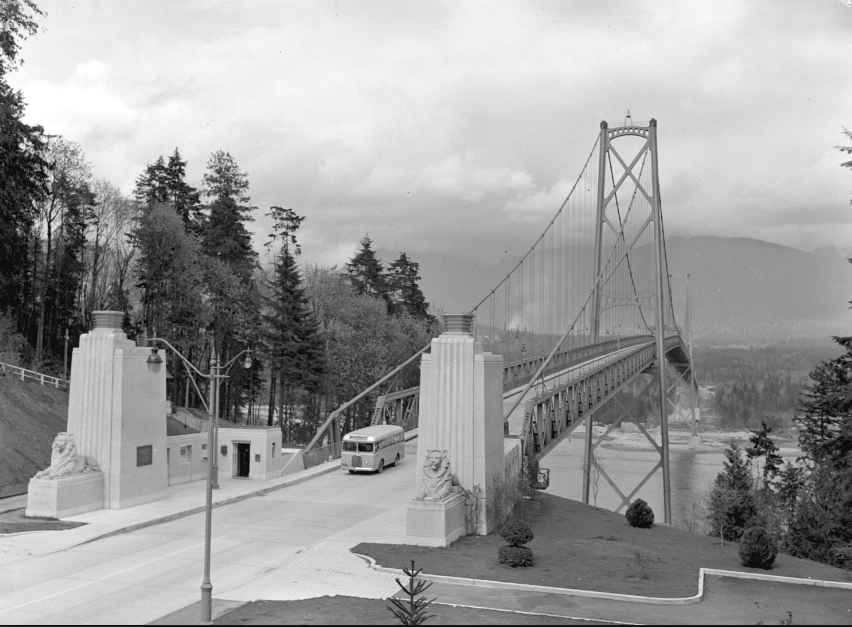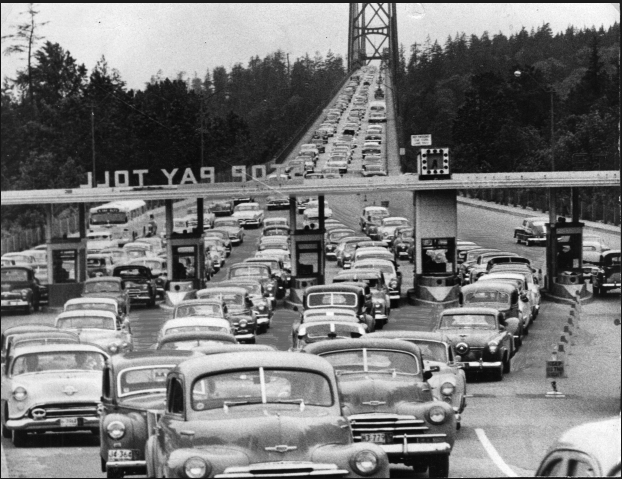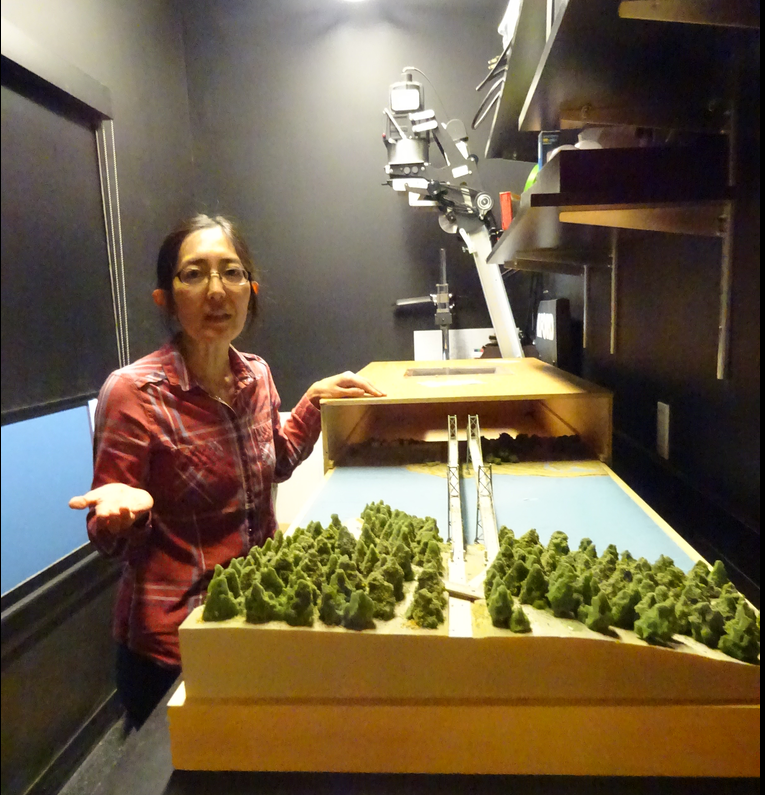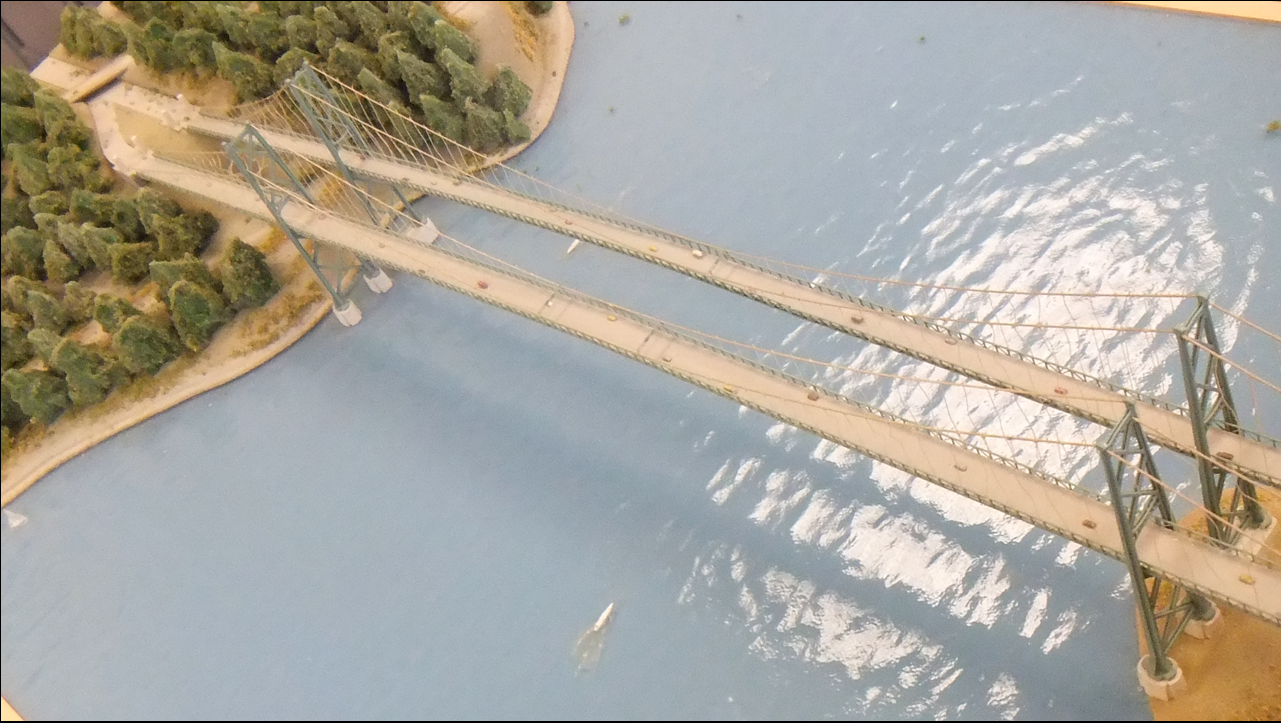
From Vancouver Exposed: Searching for the City’s Hidden History
Last year, Daien Ide, reference historian at the North Vancouver Museum and Archives was sitting at her desk when she got a tip. A 1994 model of a proposed Lions Gate twinned bridge had turned up at the Burnaby Hospice Thrift Store on Kingsway with a $200 price tag.
A local had saved the model after finding it tossed out in an alley behind his house a couple of decades earlier. For whatever reason, he decided it needed rehoming, and gave it to the thrift shop.

Vancouver Sun photoThe Lions Gate Bridge spans the first narrows in Burrard Inlet, connects Vancouver to the North Shore, and is one of the most iconic structures in the city. Built by the Guinness family to encourage development after they bought the side of a West Vancouver mountain, the suspension bridge was tolled from the time it opened in 1938 until 1963.
It cost 25 cents for cars and five cents for pedestrians.
By the early 1990s, the bridge was in serious need of an upgrade or replacement and the City narrowed down the options to three proposals. One was to build a tunnel; another to twin the bridge and double the number of lanes; and the third was to double-deck the existing three-lane bridge.
In 1994, Safdie partnered with engineering firm SNC Lavalin, and the Squamish Nation, which owned the land on the north end of the bridge.
They wanted to build an identical bridge to the east of the original structure that would carry northbound traffic, while the original bridge would carry vehicles south into Stanley Park. The new bridge would be tolled, and judging by the model, cut a chunk out of Stanley Park.

The scaled model is clearly identified with the name of the architectural firm—Safdie Architects. In Canada, Moshe Safdie is a highly regarded architect, known for the Expo 67 Habitat in Montreal, the National Gallery in Ottawa, the Montreal Museum of Fine Arts, and our very own Vancouver Public Library.

As we now know, the Province chose the cheapest and least controversial option, electing to widen the three-lane existing bridge and replace the main bridge deck.
In 2005, the Lions Gate Bridge was designated a National Historic Site of Canada.
Our traffic problems persist.
© All rights reserved. Unless otherwise indicated, all blog content copyright Eve Lazarus.




10 comments on “Saving History: Twinning the Lions Gate Bridge”
What a good idea. Especially if the new bridge looks identical to the existing bridge when viewed from everywhere except from the air. When viewed from the air the new bridge will be shown to have a either 4 / 5/or6 lanes. Dedicated transit lanes for buses.
Great idea . I wonder if the new greendp government would like to build a bit of history and try to push this project forward?
I for one am surprised I didn’t hear about this proposal when the province was working on the bridge.
I can only assume the twin was strangled in its cradle. A twin bridge (by Safdie no less) just makes too much sense, so the government had to kill it quick before the people found out about it.
Another true crime story for you, Eve.
The twin bridges are absolutely beautiful. Nothing ‘in your face’…just quiet beauty. Yes, we still have a big traffic problem.
There are no congestion problems for people who walk, cycle or take transit. I don’t know why so many people insist on driving and then complain about congestion.
I was very aware of this proposal when it was under consideration. I was assigned to attend a series of meetings with the principles on behalf of the Federal Government, and produced briefing notes as the discussion progressed. I remember that there would have been a substantial Federal investment required on behalf of the Nation, even though there was solid interest from the financial players who were interested in buying into this project with the Nation. I dont recall the final details, but know that quietly the meetings stopped, and the idea was set aside.
Eve: You might not want to post this, but you may if you wish. I have written it with as little detail as possible to make it clear it was a real proposal, which much money was spent on, before it was abandoned.
Thank you for this info. I was unaware, possibly because I have more interest in trying to get out of Delta other than the Massey Tunnel.
[…] Eve Lazarus looked back on a failed effort to ease Vancouver’s traffic congestion by twinning the Lions Gate Bridge. […]
Twinning would be a great idea. Problem: all of the bicycle lanes now downtown would mean that cars would be bottle necked…an idea might be…two ways for both bridges…one being access to and from West side of Cap River and then for those headed to Or room North Van use the other bridge. Then each bridge could have a dedicated bicycle and pedestrian lane.
Surely a single lane in or out of town half the time is adequate for a city like Vancouver? While becalmed in traffic, trying to estimate the number of concrete bolts securing the approach fencing designed to prevent motorists rapidly moving away from their cars in case of fire (Tesla instructions are evacuate the area and allow to burn out for up to 24 hrs) I am thankful for the opposition to more crossing lanes, as truly, more people would actually use them.
Carol Brett must also be grateful to the Province for rejecting the 1957 offer made by Hugh Martin, (whose firm was building the Massey Tunnel) to increase it to three lanes each way for a few hundred thousand dollars more. Think how gasoline sales and taxes would have fallen without the daily idling!
[…] In 2005, the Lions Gate Bridge was designated a National Historic Site of Canada. Eve Lazarus’ blog contains a further description and photos of the proposed bridge twinning. […]